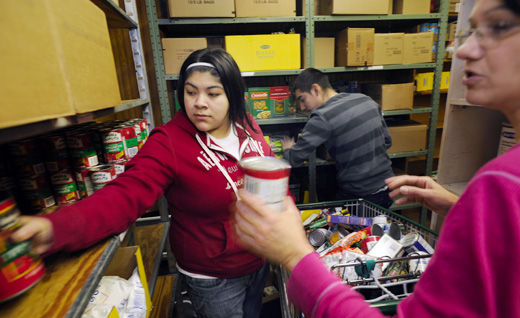
CHICAGO – In Illinois, the number of families in need of food assistance has jumped nearly 13 percent from only a year ago. This is according to recent statistics from the state’s food stamp program. Although the unemployment numbers may be falling in the state, hunger continues to rise in record numbers.
Numbers from the Illinois Department of Human Services show about 857,000 households enrolled in the Supplemental Nutrition Assistance program in December, 12.7 percent more than a year earlier.
The Great Recession job loss drove numbers up in all seven counties in the Chicagoland area. The largest increases were in suburban DuPage, Kendall, Kane and McHenry counties.
The numbers continue to climb each month and more people are seeking help at food pantries.
“Thank goodness we have the food stamp program,” said Melissa Travis, director of food services at the Peoples Resource Center in Wheaton, Ill.
Travis has lived in DuPage County for 20 years and has been with the non-profit center for six of those years. She says the number of people getting assistance at the center’s food pantry was up 25 percent two years ago, and last year it was up 20 percent.
“Our numbers have gone through the roof,” she said.
“These are families that never imagined they would need to seek help,” she said. “Many are just stunned that they’re actually in this situation in the first place.”
Travis described who she sees at the center and in need:
“We’re talking about middle class families where one or both of the breadwinners have recently been laid off. They don’t have any money and were probably living paycheck to paycheck before, with no real safety net available.”
Luckily federal funding for the food assistance program was increased under the Obama administration, which has really helped a lot, Travis notes, because then “more people have access to go to the grocery store and buy basic foods.”
“But the economy is truly the real story here,” Travis said.
“Corporations may be seeing relief, but people at the bottom have not. When people don’t have enough food to feed their families it’s not just a political issue, it’s a moral one. We are living in a country that has an abundance of resources and we need to mobilize them for people who need them the most especially in a crisis like this.”
Travis credited the generosity of the community for donating food and resources, which is one way to deal with the problem quickly and efficiently.
Travis said the resource center was established 36 years ago, and serves those most in need with a free clothing closet, homeless prevention programs, computer literacy classes, a GED program, job assistance courses and a food pantry.
Nearly 468,000 households in Cook County, which includes Chicago, received food stamps in December. The largest increase of 30.3 percent came in McHenry County with a rise to 7,265 households.
Another person on the front line of hunger and food insecurity is Bob Dolgan with the Greater Chicago Food Depository. He said the recent numbers don’t surprise him.
“The recent numbers are just a reminder that we haven’t seen the end of the current recession,” he added. “The numbers are indicative of people that are still very much in need of help.”
The Food Depository has a network of 650 pantries, soup kitchens and shelters in Cook County. They have reported serving about 65 percent to 70 percent more people since 2007.
We gave out about 66 million pounds of food in 2010 alone, said Dolgan.
Diane Doherty, executive director of the Illinois Hunger Coalition, tied hunger with home foreclosures, health care and pension benefits for seniors and working people.
“I don’t think the numbers are going to get better,” she said. “What we need is leadership that starts looking at this problem in a deeper way and not just as an emergency.”
This recession didn’t start overnight, said Doherty adding, it’s been brewing way before the Obama administration came into office, and was created by the previous administration.
“The food stamp program was never supposed to be the main-stay for families in need when it was created but it has become the only game in town for so many,” she said.
In Illinois, there are 1.8 million people receiving food stamps.
“It’s an amazing program — along with unemployment benefits. We need to support these federal programs, but they cannot be the long-term solutions in helping us get out of this crisis or how to avoid one in the future,” said Doherty.
According to Susan Hurley, director of Chicago Jobs with Justice, “The solution is clearly living wage jobs.”
If people had good jobs then they would be able to pay for their basic needs, she said.
Photo: High school students help stack groceries at a food pantry on Jan. 17, during the Martin Luther King day of service in Racine, Wisc. ( Scott Anderson/AP/Journal Times)











